How to Play Pickleball – The Playing Beginner’s Guide
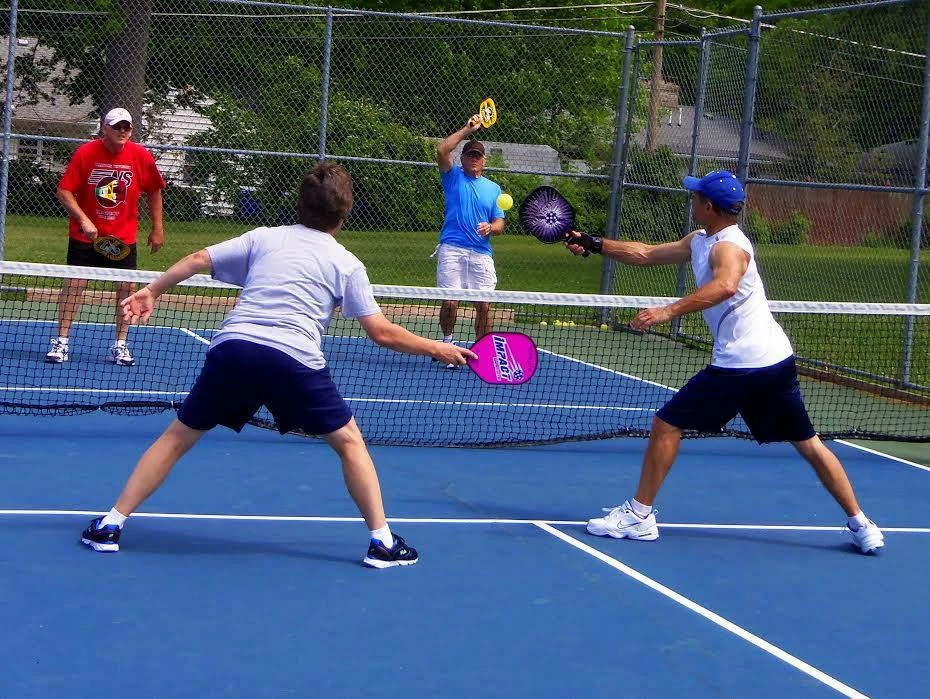
Table of Contents
Pickleball Beginners Guide Explained
How to play pickleball is the question everyone asks. Pickleball is a paddleball sport that incorporates elements of badminton, table tennis, and tennis. Two or four players use solid paddles made of wood or composite materials to strike a perforated polymer ball with 26-40 round holes over a net, similar to a Wiffle ball. You can master the art of how to play pickleball by reading this detailed How to play pickleball guide.
There’s no need to think about sprinting from one side of the court to the other since the game is designed for minimal movement on the court. It’s no surprise that pickleball is the fastest-growing sport in the country due to its unique structure and rules.
It’s not uncommon to see seniors and children playing on the same court! As a result of its growing popularity, this sport is now commonly played in local gyms, community centers, parks, and backyard courts. We have answered all your questions about how to play pickleball in this detailed How to play pickleball beginner’s guide.
How to play pickleball?
Pickleball is a quick-moving sport that incorporates aspects of ping-pong, badminton, and tennis. Because it is so simple to learn and play and doesn’t require a lot of equipment, paddleboard sports are quite popular. Paddles, a pickleball, and a pickleball court are all that is required. Learn the court’s layout whether you’re playing singles or doubles, and abide by a few basic rules for a thrilling back-and-forth match!
Every round begins with an underhand serve from outside the court’s boundaries on one side. As in tennis, you serve the ball diagonally across the court. After being served, the ball must bounce once on each side. After that, you can either smash it or let it bounce once.
The non-volley zone, commonly known as the “kitchen,” is located on each side of the net and is not accessible to players. Furthermore, services are not permitted here.
How do you play pickleball?
How to Play Pickleball? Pickleball is played on a court, although the rules are more similar to table tennis or badminton than traditional tennis.
The game begins with one side serving the pickleball, using the paddle (which is bigger than a ping pong paddle and made of wood or composite) to strike the pickleball (which is a light, plastic, hole-covered whiffle ball).
To serve the ball effectively, the player must stay one foot behind the backline and strike the ball with an underhand swing, aiming at the service court diagonally over the net and clearing the no-volley zone.
How to play pickleball singles?
Despite the similarities between singles and doubles pickleball, doubles pickleball requires a totally different strategy because there is only one player on each side of the pickleball court.
Most pickleball players have ambivalent feelings about singles pickleball. This may be because singles pickleball is difficult and time-consuming. Singles pickleball may be a difficult workout because you have to cover the full pickleball court by yourself (even more so than doubles pickleball). It may also be because playing pickleball by yourself when there is just one other player on your side of the court can be quite isolating. In other words, you don’t have somebody to lean on or a support system.
How to play pickleball doubles?
Pickleball doubles is a dance. It necessitates rhythm, nonverbal communication, and focus. Just as they must identify your vulnerabilities, you must also get familiar with your partner’s. You should work on this with your spouse until you have developed an unspoken connection that enables you to move and behave freely while yet being in synchronicity with them. The possibilities are endless for you if you can learn the aforementioned techniques and apply them to your game with your partner.
How do beginners play pickleball?
Hit 50% of your attempts at each player. Give them a shot that they can take comfortably. Here, you’re practicing your placement and quickness. They ought to return a ball with some force. It’s good for you since you need to practice making accurate shots. Give them a few quick jabs to the shoulders. Allow them to hit you. Get them back if you are that good.
Don’t even try to smash the ball or make a shot. It is intended that they return the ball so you may practice your talents. Alternatively, inform them that all of your shots will be sluggish and into the NVZ. You require practice from every player on the field. Most of those will be returned by them.
How to play the kitchen in pickleball?
According to the pickleball kitchen rule, a player must hit all volleys outside of the non-volley zone (the kitchen). In conclusion, players are not permitted to touch the kitchen line or enter the kitchen when volleying the ball. Prior to being stepped on by the person in the kitchen, the ball must have bounced.
How to play pickleball on a tennis court?
The easiest method is to simply lower the middle of the tennis net to 34″. Pickleball court lines can be painted or taped (always check with the facility first). Then, it would be very simple to play pickleball and tennis on the same court.
How to play pickleball like a pro?
How to play pickleball like a pro is not a difficult thing to do. Use your forehand for power, particularly on serve returns, but also work on your backhand to round out your game. Placement is crucial; prioritize control over speed. Power is not as vital. Try not to attempt many sideline shots; they have a poor success rate.
How do you place a pickleball shot?
Aim for the baseline, five feet away, and the center line, one foot away (usually their backhand). Attempt not to try to strike it rich at this time. Always prioritize placement over speed. Never strike the ball more forcefully than necessary.
How to play net in pickleball?
The ball drops over and strikes the horizontal bar instead of the center foot of the net in the same scenario. You repeat the point even if that is a let.
The horizontal bar on your side of the net is struck by the ball as you strike it. That is a mistake and a setback for the rally.
How to play king of the court pickleball?
At the baseline, everyone lines up beneath the rim. Up until one point, the first two players in line engage in one-on-one action. Each possession has a 5-dribble limit after which the ball belongs to the opposing player. You may make them compete for the rebound, and the winner takes the ball, checks it up, and then the exercise is resumed.
Legitimate Sport
Pickleball is a legitimate sport that is also a lot of fun! Consider it a cross between table tennis and traditional tennis, as well as badminton. A net, a court, paddles, and a light ball are everything you need (similar to a whiffle ball). As in traditional tennis, players can compete in singles or doubles.
Since the court is smaller than a tennis court, play is more compact and less strenuous. Pickleball, on the other hand, is a great way to get outdoors and have some fun because it’s not dangerous. You won’t even realize you’re exercising while playing this fun game!
Look no further if you want to try a unique new sport that everyone can participate in. Continue reading to discover how pickleball came to be, how to play, the rules and lingo, and the best pickleball equipment for you!
Understanding pickleball can be frustrating for beginners, whether they choose to take it up as a hobby or become a professional. If you’re just getting started, you should take things slow and focus on getting a general understanding of the sport rather than jumping right into the technicalities.
History of Pickleball
In the summer of 1965, Joel Pritchard and Bill Bell, bored with their families, invented pickleball. They went into Pritchard’s garage to see what they could find, eager to make a game that was suitable for the whole family. He found ping pong paddles and a perforated plastic ball after some rummaging and proceeded to the badminton court.
They quickly discovered, with the aid of their friend Barney McCallum, that they could easily bounce the plastic balls off the ground. Soon after, the designers agreed to reduce the height of the badminton net from 96” to 36”. Pickleball, the sport we’ve all grown to love, was born after a few games.
The Word “Pickleball”
Pickleball has appeared in print under several meanings as it has increased in popularity over the last five decades. The word “pickleball” is a single word that is capitalized only when it appears at the beginning of a sentence, in a title, or as part of a proper name, such as a pickleball equipment company’s name.
Pickleball was founded in 1965 on Bainbridge Island, Washington, just a short ferry ride from Seattle. Joel Pritchard, Bill Bell, and Barney McCallum, three fathers who were bored with their children’s normal summer activities, are credited with inventing the game.
Pickleball has become increasingly popular in the United States and Canada as a result of its unique handmade equipment and simple rules. The game is also growing internationally, with courts being established in several European and Asian countries. Tap here to read more about the history of pickleball.
Why is it called Pickleball?
Pickleball is a unique name, particularly because no pickles are used in the game. The origins of the name are disputed.
This is a crew of oarsmen who have been leftover from previous vessels. The second hypothesis claims that it was named after Pickles, the Pritchard’s dog. The dog will chase after the ball and carry it down.
Pickles the dog did not appear until two years after the game was invented, according to Joan Pritchard. As a result, the dog’s name was inspired by the game. It’s true, though, that the game didn’t have a formal name until the dog showed up to inspire it.
Others contend that both sides could be right. The game had no official name in its early years. The Pritchards bought a cocker spaniel called Pickles a year or two after the game was invented. As the game progressed, the need for a name became evident, and “pickleball” was chosen.
Learning Pickleball
Don’t worry if you don’t know how to play pickleball. Pickleball isn’t difficult to grasp. It just takes a little while. Pickleball can also be mastered through osmosis. The most important thing, though, is to have fun. When playing, take advice from others and you’ll get used to it. Don’t get too hung up on the rules’ specifics (more on that later.) Simply aim to have a good time and focus on the task at hand.
To begin, make sure you have some water with you. It’s important to stay hydrated when playing pickleball. If you’ve done some previous research on pickleball before reading this article, you’re probably aware that it’s a low-impact sport. To begin with, this is only partly true since it makes no mention of how tired you will get. It can be very exhausting.
How to start playing Pickleball?
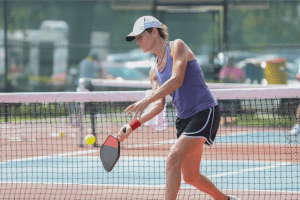
It’s a basic sport that is also inexpensive. All you need to get started with pickleball is a paddle, a pickleball, some comfortable shoes, and a place to play. This sport can be played both inside and outside.
With the popularity of pickleball in the United States, many community centers now offer the sport. Thus, in today’s world, finding a spot or balls is not an issue.
Rules of Pickleball
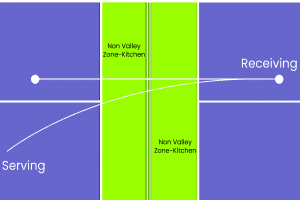
Pickleball is a simple sport to learn, but mastering the rules takes time. You don’t want to place too much pressure on yourself when you’re first starting; instead, you want to enjoy the learning process. When you’re first starting out, talk to more experienced players for advice.
Pickleball rules are relatively simple, except for two rules that give professional players headaches as well. What exactly are these guidelines? We’ll read more about them further down. But first, let’s take a look at pickleball paddles and see which ones are suitable for beginners. By following the above mentioned rules you will get to know how to play pickleball.
General Overview
- Pickleball is a sport that can be played as a single or doubles game.
- The serving team is the only one who scores points.
- The game is won by the first team by 11 points with a 2-point advantage.
- The game starts with one side serving the pickleball and hitting it with a paddle (which is made of wood or composite and is bigger than a ping pong paddle) (which is a light, plastic, hole-covered whiffle ball).
- The right-hand court is where the service begins. Only one mistake is permitted.
- In doubles, both teams get a chance to serve once before the opposing team takes over the serve.
- To serve the ball properly, the player must stand one foot behind the backline and hit the ball with an underhand swing, aiming for the service court diagonally across the net and clearing the no-volley zone.
- From the start of the game, both sides must allow the pickleball to bounce before hitting it with the paddle at least once. Players may then volley the ball (hit it without allowing it to bounce) as long as they are not within the no-volley line, which is within seven feet of the net (marked on the court).
- When a player or team serves, he or she is awarded points. A pickleball game is played to 11 points, and a two-point victory is needed to win.
The following moves are faults in pickleball that result in a point loss, similar to tennis:
- The inability to clear the net.
- The ball has left the field and is now out of bounds.
- Volleying the ball with one foot in the no-volley zone or from inside the no-volley zone.
- Volleying the ball until it bounces on a first serve or first return.
Scoring
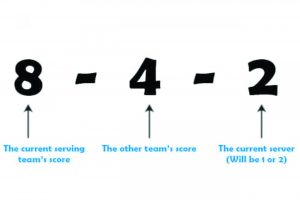
- Three numbers are used to represent the score: 1) score for the serving team 2) team score receiving, and 3) server number (one or two)
- The score is called out “zero-zero-two” to begin a match; In traditional doubles, each player on a team gets a turn serving before the service is passed to the opposing team. Only one player from the serving team will serve on the first serve of the game before the ball is passed to the opposing team. As a result, before the game changes, the first player to serve calls out “zero-zero-two” to show that they are the final server on their squad.
- If a point is scored, the server shifts to the left side of the court and serves again, and the serving team alternates as the points are scored.
- They score if their team’s serve is good and their opponent’s serve is poor.
Serving
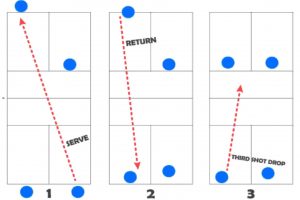
Following these serving rules after determining which team will serve first:
- The first serving must be taken on the right side of the court, and then a rotation between the left and right sides is allowed.
- The server must call the score and put both feet behind the back line before serving.
- A backhand motion is required for the serve.
- Just before a serve, the ball must be struck while still in the air; do not let it bounce on the ground until hitting it.
- Serve overhand only if the paddle makes contact with the ball below the server’s waist (belly button level).
- The serve is rendered diagonally around the court and must land in the opposite diagonal court’s confines.
- A single-serve attempt is permitted.
- In a SINGLE match, if the service is a mistake, the serve goes to the opposing side.
- In a DOUBLES match, if the service is a mistake, the teammate serves.
- If they also make a mistake, the server is passed to the opposing team.
Active Play
- The serving team must bounce the ball before returning it, and the serving team must bounce the ball before returning it; this two-bounce rule is known as “double-bounce.”
- Both teams can volley the ball (hit it before it bounces) or play it off a bounce after it has bounced once in each team’s court.
- You should never volley in the “kitchen,” the 7′ zone on either side of the net.
- After the ball has bounced, you are not allowed to reach the kitchen or stand on the kitchen line.
- After hitting the ball, you must immediately leave the kitchen.
- If a point is scored, the server changes sides and serves from the left side of the court. This continues until a mistake is made, at which point it is the turn of the next team to serve. (IN SINGLES, All TEAMS CHANGE SIDE.) DOUBLES: only the serving team switches sides, while the opposing team remains on their side)
Two Important Rules To Know
-
The Kitchen Rule
-
The Double Bounce Rule
1. The Kitchen Rule
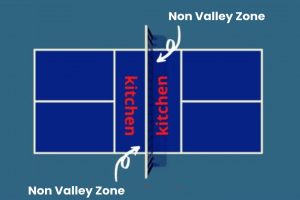 This is one of the most well-known pickleball rules. The kitchen (also known as the non-volley zone) is an area of the court that is 7 feet on either side of the net. In a nutshell, the kitchen maxim is:
This is one of the most well-known pickleball rules. The kitchen (also known as the non-volley zone) is an area of the court that is 7 feet on either side of the net. In a nutshell, the kitchen maxim is:
You can’t volley a ball with your foot in the kitchen even if the force of hitting a volley causes you to walk into the kitchen.
A volley is simply where you kick the ball while it is high in the air just until it bounces. You will easily walk into the kitchen and strike the ball as it bounces. It’s a mistake to volley it in the kitchen if it hasn’t hit the ground yet. Keep in mind that this is just for volleys. If the ball has already rolled, you can spend as much time as you like in the kitchen.
This legislation was enacted to save people from just standing at the net and breaking everything down. Of course, it would be ridiculous. The kitchen code prevents this from happening.
In the kitchen, the general rule is to position your foot 1-2 inches behind the kitchen line. When it’s time to volley a strike, hold off on taking a step forward. It takes a little getting used to, so it’s the most efficient way of practicing. Trust us when we say that you will come into the kitchen and discover a mistake many times, and we all do.
2. Double Bounce Rule
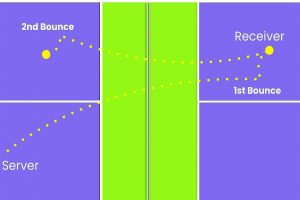 This is yet another well-known rule that always catches newcomers off guard. This rule would get me at least a couple of times a match when I was a novice. It’s very amusing when someone breaks the law because it’s fairly simple to understand. Here’s how it works:
This is yet another well-known rule that always catches newcomers off guard. This rule would get me at least a couple of times a match when I was a novice. It’s very amusing when someone breaks the law because it’s fairly simple to understand. Here’s how it works:
According to the double bounce rule, the ball must bounce once after the serve and return serve.
This ensures that the return server cannot strike the ball out of the air as it is served (volley). Also, when returning it to the working team, the return server is unable to hit it in mid-air. The word “double bounce rule” was coined as a result. Any volley must bounce once on each side before being played.
Isn’t that self-evident? My novice pickleball self would disagree.
It’s difficult to get used to this one because it’s too easy to forget. Hitting balls in the air is also a lot of fun. The only way to avoid making this error is to take a few steps forward as possible when serving the ball. If you sit in the back of the court, you won’t be able to volley the ball.
This law is far more straightforward than the Kitchen Rule. Most players are unaware that they have caused the ball to bounce twice when faced with a slow shot. What is the outcome? Points have been surrendered. After the serve and return, the ball must bounce once, which is a tricky part of the rule.
As a result, you won’t be able to hit a volley shot right off the bat. It can seem simple, but it is very easy to overlook. Volleys, in particular, are extremely tempting to strike, so you will need to make a deliberate effort not to volley right away.
Pickleball Equipment and Court
Pickleball needs only a couple of paddles, a whiffle ball, and a net to play. You can make your court out of sidewalk chalk (at least that’s what we used to do). Official pickleball courts can be found at several playgrounds, community centers, and private clubs, thanks to the game’s increasing popularity.
Pickleball courts are one-third the size of traditional ball fields and are laid out equivalent to badminton courts (20 feet x 44 feet). The court is divided by a 36-inch-high net on each edge. The no-volley zone is a seven-foot area on either side of the net (marked by a line on the court).
The main goal of the no-volley zone is to eliminate chances for smash volleys or drop shots, forcing players to rely more on shot placement. Of course, the rule provides chances for the opposing team to make mistakes, which adds to the game’s enjoyment!
Following is the main Equipment for Pickleball:
-
Ball
-
Paddle
-
Net
1. Ball
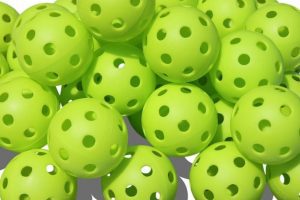 Pickleball balls are not required to be a particular color, but they do vary slightly depending on whether the game is played indoors or outdoors. Owing to wind interference on the courts, outdoor balls normally have 40 small holes and indoor balls have 26 larger holes.
Pickleball balls are not required to be a particular color, but they do vary slightly depending on whether the game is played indoors or outdoors. Owing to wind interference on the courts, outdoor balls normally have 40 small holes and indoor balls have 26 larger holes.
2. Paddle
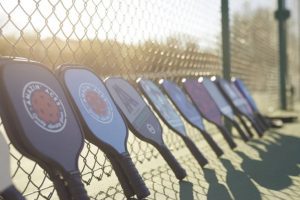 Pickleball paddles are lightweight, strong paddles that can be maneuvered easily with the wrist. Paddles are usually made of wood, graphite, or fiberglass with a special polymer heart, and our favorites can be found here.
Pickleball paddles are lightweight, strong paddles that can be maneuvered easily with the wrist. Paddles are usually made of wood, graphite, or fiberglass with a special polymer heart, and our favorites can be found here.
The best pickleball paddle is our primary weapon. It’ll be the most valuable piece of pickleball equipment you’ll ever own. It’s the center of attention. We’ll go into more depth later, but for now, I’d like to lay the foundation.
3. Net
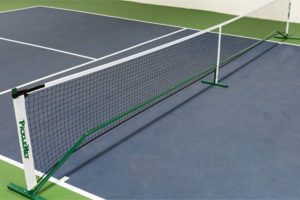 At either end of the court, pickleball nets are 36 inches long, dividing the court in half. Here’s where you can get our compact and regulation-size net!
At either end of the court, pickleball nets are 36 inches long, dividing the court in half. Here’s where you can get our compact and regulation-size net!
See Amazon Prices See Walmart Prices
The All-Important 3rd Shot
-
The Drop Shot
-
Ground Strokes
-
The lob
The third shot in a pickleball rally is always the most crucial because it allows the serving team to step up to the net and take control of the point. After the initial serve and return, the serving team hits the third shot of the rally, as the name implies. Here are several tactical tactics to help you determine how to use your third shot opportunity.
1. The Drop shot
Use when Your Opponents Are On the net. The drop is by far the most common third shot because it effectively neutralizes the action. The drop is the third shot of choice for most high-level pickle ballers. When the other team has already jumped up to the net and you are still pinned deep, this is the most powerful tactic to use. Your shot would extinguish if it lands in the opponent’s kitchen.
3. Ground Strokes
Use this tactic when your opposition has a lot of depth. The best shot is a deep groundstroke if the other team is already deep in their court after returning the serve. Don’t worry about power; what matters is that you hit a solid, well-placed shot that keeps them deep in the game. Keep your eyes peeled for opportunities to pin your opponent deep and gain access to the net.
If both players have stayed deep in doubles, position your shot down the middle, preferably to the backhand of the weaker player. Return to the player who is still at the baseline if one player has come to the net.
You might aim for winner chances on the sidelines in singles, but keep in mind that it’s a lower-probability shot. Otherwise, hitting a deep shot to your opponent’s frog is a good idea.
Where can you play Pickleball?
There are many options for finding pickleball courts in your city. If you don’t know someone who plays, you’ll have to find some spots on your own. There are, however, several choices available to you, the majority of which are inexpensive (another benefit of pickleball).
If you don’t know anybody, the next thing you can do is check for locations on the USAPA website. This is how the majority of people find new places to play.
Pickleball leagues are being organized by local sports districts, YMCAs, and private clubs, and the list is growing. Check the USAPA list first, then look at local directories for your city to see if a pickleball league exists. If not, maybe you should launch one!
Pickleball Court
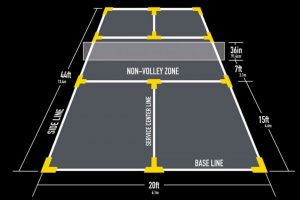
If you can’t find a pickleball court, simply lower the net on a badminton court to three feet! You may also build your court in your driveway or on another piece of blacktop. Since the service courts and no-volley zone don’t need as much room as a tennis court, it’s easy to draw the service courts and no-volley zone on a suitable area and then hang a net in the middle!
If you introduce pickleball to your friends and coworkers, chances are they will enjoy it as much as you do! Indeed, as more people become aware of this sport, the number of courts, leagues, and tournaments grows year after year. People of all ages enjoy this family-friendly game.
The Strategies of Pickleball
If you’re new to pickleball and don’t know how to play pickleball, you may be interested in some tips on how to improve your game. Here are some pointers to remember on the court.
- Serve on your opponent’s weak side if you notice their forehand or backhand is weak. It would be ideal to serve from the middle of the court. But be careful not to hit it out.
- After each volley, you return, and make sure you’re in a ready position.
- When playing doubles, strike the ball down the middle of the court. This will force your opponents to make a quick decision on who will go for it, potentially leading to errors on their part.
- You can confuse your opponent by using a particular type of shot. Use one method daily before switching to another.
- Keep the ball away from your opponent. Using shots that cause them to move to make them move.
What Are The Etiquettes Of Playing Pickleball?
While a little friendly rivalry is enjoyable, this game is all about community and having a good time. Keep these few things in mind while you’re playing, and you’ll have a great time while making lasting friendships!
- Pickleball players have the option to call the shots, which is one of the game’s most intriguing features. Give the person the benefit of the doubt if you’re not sure if the ball is in or out. Keep in mind that this game aims to have fun!
- Return a ball from another court if it falls on yours; do not exchange balls.
- Do you need to get past a court where a game is currently being played? Wait until the game is over before continuing. Walking behind the active play is both impolite and potentially risky.
- In this friendly game, there are no sore losers. Refrain from cheering and celebrating at the opponent’s expense if they miss a shot or hit the ball out of bounds.
- Accept playing with other players graciously: you may be paired with players who are either below or above your ability level. Avoid these players at all costs! Instead, graciously embrace and engage in a game or two.
What beginners need to know about Paddles
Let’s go through each of them in more depth now that you know the basics.
It’s time to learn about the paddle, which is the pickleball player’s primary weapon. You’ll have to buy a paddle if you can’t borrow one from a friend or find one at a pickleball facility in your town. Let’s start with the various styles of paddles.
Wooden Paddles
When pickleball first became popular in the 1960s, wooden paddles were very popular. They were used until the mid-1980s when composite paddles took their place. Even though composite paddles are used by 99 percent of players, wooden paddles are still used in pickleball today. The explanation for this is that they are inexpensive.
Paddles made of wood are notoriously hard. Any of these paddles can be very heavy, weighing up to 20 lbs. To give you a sense of scale, the typical composite paddle weighs about 7.5 ounces.
wooden paddles existed to help pickleball get off the field, but they’re no longer useful to us. Wooden paddles are bulky and cumbersome, making them difficult to play with.
Paddles made of wood are often very inexpensive. We’re asking for a bargain. You can take this path if you need the cheapest alternative available.
Composite Paddles
When various individual components come together to form one piece, it’s called a composite material. Consider a ham sandwich. Since the bread, ham, cheese (obviously pepper jack), and mustard all come together to form a single, tasty sandwich, we might call it a composite object.
Pickleball paddles made of composite materials are similar to traditional pickleball paddles, except without cheese. If you’re into that kind of thing.
The rest of the paddle head is made up of the heart. The center is made of a variety of materials, but they all have a honeycomb pattern. The paddle’s honeycomb construction makes it solid and sturdy while being lightweight. And that’s just what we’re looking for!
The Best Paddle For Beginners
There are inexpensive paddles available, but as a novice, it’s more important to consider what you should skip rather than what you should buy. Here are other things to stay away from:
- Paddles with a Nomex and aluminum core.
- Paddles that are elongated or “bladed.” These are the paddles that seem to be skinny.
- Wooden paddles of any sort should be avoided.
- Paddles weighing less than 6.5 oz or more than 9 oz.
You’ll be in a good starting spot if you stay away from these paddles.
One is a lightweight paddle, and the other is a paddle with a high midweight. Keep in mind that these are the highest-quality alternatives I’m aware of that won’t split the bank. These are the types of paddles you can use for a long time before switching to a more sophisticated model.
Paddletek Phoenix LTE
The value of this paddle cannot be overstated. If money isn’t a problem, don’t buy a pricey paddle at the outset of your pickleball trip. You’ll never be able to guess what will occur in the future. The last thing you want to find out after a month is that your $150 paddle isn’t working out or isn’t right for you.
Since it’s built to be a soft paddle, the Phoenix LTE is also ideal for beginners. When people say “soft” in pickleball, they mean that the ball would pop off the mask in a much more delicate way rather than bursting. This is the biggest reason why I advise beginners to get the Phoenix LTE. The paddle will instruct you on the fundamentals of pickleball.
The best part about these low-cost paddles is that they always come in packs. In pickleball, you’ll see this a lot. Since the game needs two to four players to play, retailers prefer to market sets and packs to make your life simpler and save money. Bundles are a perfect place to go if you want to play with your partner or a friend.
Two paddles, a basic pack, and four balls are included in the Phoenix LTE kit. The balls would most likely be of poor consistency, so that isn’t a big deal right now.
Specifications:
- A polymer as a core
- Composition of the face
- 1 oz. average weight
- 15 34” is the length of the paddle.
- 7 34” Paddle Diameter
- Circumference of the grip: 4 14”
- Gamma perforated ribbed grip form.
- 4 12” handle length
- The USAPA has given its approval.
On the market, this is the finest beginner paddle. Because of its low price and high specifications, the Paddletek Phoenix LTE is an ideal option for beginners. It isn’t the cheapest paddle around, but it is a decent value.
Here are a few advantages:
- It’s light and easy to use.
- It’s ideal for both seniors and children.
- Cost-effective.
- Touch is gentle.
- The paddles are packaged in a two-paddle kit of balls and a bag.
Let’s pass on to the next paddle guideline if you want to rely more on strength than finesse.
Selkirk NEO
This is the second beginner paddle we suggest. Selkirk is one of the most well-known pickleball manufacturers in the world. While this paddle, the Selkirk NEO, was created several years ago, it is still a fantastic beginner paddle. Below are some of the advantages of using this paddle:
- It’s a little less expensive than the Phoenix LTE.
- Paddles in the upper midweight range have more strength.
- Young people and good players will enjoy this game.
- Bundles of two paddles with balls are available.
Specifications:
- Polymer is used for the core.
- The face is a composite.
- 8 oz. average weight
- 15 12” Paddle Length
- 7 58% Paddle Diameter
- Circumference of the grip: 4”.
- Gamma is a grip type.
- 4 7/8” handle length
- The USAPA has given its approval.
Take care of your feet!
Let’s talk about what to have on your feet now that we’ve discussed what to have in your hands. When it comes to pickleball, the shoes we don are crucial. In reality, much of this debate can get very heated. Pickleball puts you at risk for bone fractures and other health issues. There are a few things to keep in mind when it comes to footwear.
Pickleball, for one, does not need a lot of forwarding movement. For a long time, I heard people say something like, “In pickleball, there is no going.” That seemed ridiculous to me. However, it is scientifically right. Pickleball does not allow for racing. Instead, there are sprints.
In pickleball, though, apart from light jogging forward and walking, sprinting is the only forward step you’ll see, and it doesn’t happen too much.
So, in pickleball, what are the most popular movements?
Lateral movements.
Lateral gestures are side-to-side motions of the leg. In pickleball, there is a lot of this. And it’s usually continuous and frantic. If you don’t have the proper footwear, you risk rolling your ankle or developing shin splints or stress fractures. I’ve had shin splints before, and trust me when I say you don’t want to go there.
People usually play pickleball at one of two styles of venues. Pickleball is played on tennis courts, whether indoors or outside, in the best quality areas. The other choice is to do so in a gymnasium with a wooden floor. This may be a basketball or volleyball court. They’re essentially the same.
It’s not unusual to see basketball, tennis, and pickleball lines written all over the court at a pickleball venue. Wearing a durable court shoe is the best choice for these gymnasium sites.
Tennis shoes
Can you recall those cool-looking shoes you used to wear as a kid? When it was time to play outdoors, you would put your sneakers on, tie them, and run around for hours until you were absolutely tired. This is something I recall seeing in the 1990s. Another thing I recall is that I referred to those shoes as “tennis shoes.” They weren’t tennis shoes, though; they were more like running shoes.
Tennis shoes have the following characteristics:
- The shoe is very heavy on both sides.
- Far more so than most forms of footwear.
- Instead of bending in the center, it bends at the toe.
- Very long-lasting and tough.
Investing in a pair of tennis shoes is the safest choice for boots. This is particularly true if you plan on playing tennis on a real tennis court. In this case, there is no alternative. The surface of the tennis court is very rugged and textured. I joke that it’s like working on sandpaper at times. Tennis shoes are the only choice if you’re going to be playing on a tennis court.
Good Pickleball Strategies for Beginners
-
Quick Movement
-
Less Showboating
-
Drop Shots
1. Quick Movement
Keep those feet going and don’t stop too long. And when their rivals are pushing them, most beginners hang back. Often aim to hit the net to avoid being stuck in no man’s land. After the initial shots have been taken, aim to get into the kitchen as quickly as possible.
For many older players, this may be a major stumbling block. If you have the determination, you will be able to move fast enough to score a point from the kitchen.
2. Less Showboating
The poor return is adored by all opponents. Many novices want to hit the winner so they can fist pump. In pickleball, however, the odds of your fist-pumping shot being an unforced error are very high.
Don’t slam the ball into the ground too hard. With little to no effort on your opponent’s part, the harder you strike, the quicker the return will be. Allow your opponent to make the mistake by being careful and reading the game. As a novice, your main focus should be on consistently bringing the ball over the net.
3. Drop Shots
Drop Shot – A quick serve-return-dink return shot with a forwarding movement towards the net. In pickleball, one of the most underutilized shots is maybe the best way to score simple points. The difficulty of landing a drop shot intimidates most beginners.
In reality, the majority of them are afraid to even approach the internet. Pickleball is a game where the person who controls the net is the one who controls the game. Drop shots, on the other hand, allow you to get into a good position before attempting a point-scoring shot.
20 Points to Consider for Beginners Starting with Pickleball:
- Offer pickleball the respect it deserves by stretching before your match, just as you would with other high-intensity sports.
- Stretching and jumping ropes will help you loosen up in between games.
- To should the risk of injury, wear tennis shoes and avoid all other footwear.
- Attempt to reach a deep serve with little to no spin.
- Serve straightforwardly to prevent unforced errors.
- It’s fine to arc your serve higher at first but focus on making them correct.
- For a forehand shot, keep your body aligned.
- Enable your opponents to make unforced errors by playing safe and easy.
- Maintain your energy level in the game and don’t rush up for volleys.
- Attempt to hit the open spaces with your arrows.
- At any time of day, choose precision over power.
- Practice throwing your body momentum in the same direction as the kitchen rule.
- Rising shots should be taken with care.
- Setting shots should be taken with a lot of force.
- Keep your knees slightly bent, your feet shoulder-width apart, and your paddle between your knees.
- Your smash shots should be aimed at your opponent’s feet or the open area.
- By exhausting your opponent’s kitchen, you will gain an advantage.
- In the kitchen, practice landing drop shots.
- If you want to perfect your aim, don’t lob.
- Just work the court as much as your body would allow.
Top 10 Mistakes Made By Beginners
The following are some of the most common mistakes we see new players make. Concentrate on removing these from your game, and you’ll become a much more successful player!
To help you better your game, be aware of these common blunders.
- You can’t win the point if you can’t get the ball into play if you miss (fault) on your serve!
- On the return of your opponent’s serve, make a fault. You opt for a low-percentage ‘hero shot’ instead of a high-percentage return down the center.
- Poor court understanding and positioning. The biggest issue we have is not playing up at the non-volley zone line and instead of remaining down at the baseline.
- Putting a premium on control over placement. A shot struck at a normal speed and well-positioned can be much more successful than one struck quickly.
- Allowing the opponents’ shots to go out. Make sure you’re mindful of your surroundings so you don’t miss a shot.
- You tend to be too accurate with the return when faced with a tough shot from your opponent. It is preferable to make a return on a high-percentage shot. It’s fine to be defensive!
- Instead of deferring to your partner’s stronger forehand shot when playing doubles, take the shot on your backhand.
- You lose track of time and get irritated with your partner. A divided (pickleball) house cannot stand!
- Not concentrating on holding the ball as close to the opponent’s feet as possible. Keep the ball low and near their feet to avoid trouble from a ball in the air that your enemies might reach.
- Instead of hitting down the middle of the court between your rivals, go for hero shots down the courts.
Conclusion
Pickleball is a hybrid sport that incorporates elements of tennis, badminton, and table tennis. It is played on a court the size of a badminton court with a hard surface. The court’s lines are identical to those of a tennis court. It employs paddles that are bigger than those used in table tennis but smaller than those used in tennis.
Pickleball is a fun game to play, most people think that it is much similar to tennis but it is not and it is not as easy as it seems especially not for beginners that have to follow certain rules and strategies to master this game. A beginner should choose the best paddle as per their skills and keep the ball as low over the net as possible. The higher you hit the ball, the more likely it will be hit down for a winning point by your opponent. You have the option of driving or dropping or shooting the ball into the kitchen. It’s always a good idea to smash the ball to the backhand of your opponent (which is normally the weakest spot).
